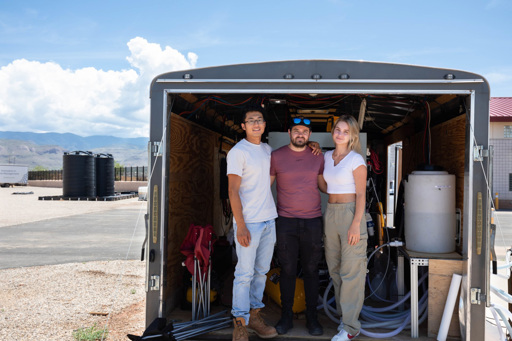You can make your own:
https://patents.google.com/patent/US20170050868A1/en
There’s still a battery, but its storage for the solar pannels, unless they’re using a different method.
Hang on a sec. I’m trying to understand something here. Lets say there is a huge amount of salt from all the processing, is the salt so bad that it cannot be consumed, or there is just too much salt that it exceeds consumption?
It’s just a lot of salt. Seawater (on average) is 3.5% salt. So for 1kg of water (aka 1 liter) you get 35 grams of salt. For 5 thousand liters, thats 175kg of salt. While we do use salt for industrial purposes, that salt is usually treated and chemically processed for sanitary reasons. Given the average person uses 310 liters of water a day (drinking, cooking, cleaning, ect…) 5,000 liters gets you slightly more water than 16 people are going to consume in a day. And 175kg of salt is way more than 16 people are going to use in a day. Now figure this system runs all year round, and we have 63,000kg of salt. Just so 16 people could drink desalinated sea water all year.
There are a number of theories put forth in recent years how best to desalinate sea water for drinking water and disposing of that salt, most of them involve dumping it in the desert, burying it in old mines, or possibly deep sea operations where salt concentrations are already too high for most life to exist, so adding salt to those regions won’t have a ecological impact and it’s possible for currents to spread that excess salt over a wider area.
Every one of these options has downsides, but we do need water to live and oceans are a vast source of water we aren’t really tapping so you can see the desire to utilize them when majority of the global population lives within a hundred km or so of a coast line.
Thanks for taking your time to explain! Guess its now how risk adverse are we, and judging by that, not really are we?
Approx 35 grams of salt per litte. 35 g x 5000 litres per day is about 385 pounds of salt everyday. This is the problem with desalination no one discusses.
On the low end people use around 300 litres a day. So this is only enough water for 16 people. When you start scaling this it really becomes clear.
Let’s say you wanted to provide LA with water from desalination. At around 23 pounds of salt from 300 liters of water per person with LA population being 3.8 million that would make 87 million pounds of salt… wait for it… per day!
Sure you can put it back into the ocean, but that is not good for sea life at all. Not to mention all the energy needed to pump it back if that is what you choose to do. I don’t think sequestering is an option either.
Here I thought it was an oversized fish bol, upside down, using the sun to evaporate water.
Silly me.
Do you come with the desalination system? Heh heh.
Why battery free?
Batteries are cheap and great.
Oh its refried MIT garbage. Ok.
Batteries are not cheap, especially on industrial scale. And most batteries are not ecologically friendly. It makes far more sense to put all the power solar panels produce during the day to immediate use for maximum efficiency, there is no form of battery that exists that doesn’t have some kind of efficiency loss.z
Putting a battery on this is like building a water tower in your front lawn that only feeds your sprinkler, and you’re only filling it from a hose. You don’t really get any benefit out of it and it’s just easier to run the hose right to the sprinkler anyways.
Edit: loads of gullible people here wanting to buy a bridge! Please invest your money and I’ll wait for the inevitable “how could we have known this was a scam, nobody told us!!”
Yeah I’m sorry but I’m right out of the gate calling this a scam.
I’m not saying it is a scam but I’ve seen so SO many “free drinkable water!!” scams built by scamming absolutele idiots, that I’m first assuming this is bullshit until I’ve seen the actual designs and products for real
Again, not having read the article: if this is something with “please fund us, we will make it awesome” then you better close that wallet fast as you’re about to be scammed.
It doesn’t matter if it’s university backed or not, even Stanford and MIT backed scam projects that first graders could have identified as a scam and turned up nothing
Unless they have a fully functioning system that produces at least 5000 liters of drinkable water per day, every day, this is a scam. I’ll read the article after and update.
Having said all that, depending on where you are that can support a village or a single village idiot.
Edit: having read the article, I’m still staying on the “scam” part. For one: “In addition, unlike other systems, this one does not require batteries to store energy nor does it depend on an external electrical grid.” is bullshit. If you want it to run at night you either need batteries, the power grid or a little garden gnome furiously cycling to power a generator. As said before: that it’s backed by MIT says little to nothing
Your calling it a scam right out the gate. But you’re not saying it’s a scam. And you’re not reading the article.
10/10
And you didn’t read what I wrote.
I said most of these revolutionary techs are scam, because I quite literally see new scams like this on a near weekly basis. I’ve literally seen dozens of these revolutionary drinkable water miracle machines over the past decade and so far 100% of it was a scam so pardon me for being at least skeptical.
Arguments like “but MIT is involved, MIT!!” hold no water either because MIT and Standford have been involved in similar scams before, lending their name and credence to it.
Also, again, you didn’t read what I wrote. I did read the article and sorry, it’s not convincing.
Maybe YOU didn’t read what you wrote.

Before waxing philosophical you should learn effective communication skills. And I’m not the only one who thought your opening lines were nonsensical.
During six-month trials in New Mexico, the system harnessed 94% of the energy generated by the solar panels, maintaining a constant production of drinking water even with fluctuating weather, producing up to 5,000 liters of drinking water per day without the need for batteries or an external power source.
It looks like it’s just a test/demo of plumbing reverse osmosis desalination directly into solar power. I’m guessing there is mechanical energy buffering in the system, meaning that batteries aren’t required to smooth power flow out.
You contradicted yourself in your opening two sentences. I’m going to assume the rest of your comment is just as confused and skip it.
That’s alright, you go buy that bridge, buddy
Man, you really got me there. Anyone who calls you out must be insane, because you are above reproach.





